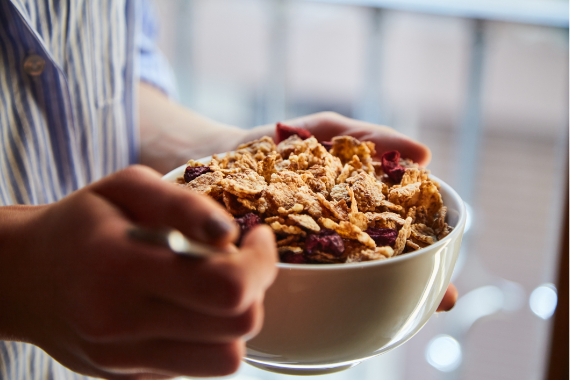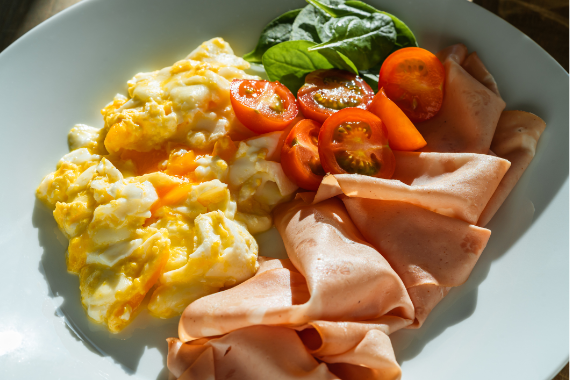Before an important meeting, such as a job interview, a public event or a presentation of a project to your bosses, what do you have for breakfast? Toast with jam? Croissants, pastries or biscuits? Maybe a bowl of cereal?
It may seem like an irrelevant question, but a recent study suggests that eating a breakfast loaded with rapidly assimilated carbohydrates (products rich in sugars and refined flour) causes a drop in facial attractiveness—you look worse—within a few hours. This is important given that physical attractiveness is a key factor in interpersonal relationships, whether social or professional, when it comes to generating empathy and inspiring trust.

It has long been known that a diet rich in refined carbohydrates favours the development of various diseases and ailments: obesity, type II diabetes, insulin resistance, cardiovascular disease, Alzheimer’s, high blood pressure and even near-sightedness, to name but a few. These disorders are caused by the development of persistent hyperglycaemia (high blood sugar) and hyperinsulinemia (high blood insulin levels).
In addition, hyperinsulinemia interferes with growth factors, which are responsible for tissue repair, and stimulates the synthesis of sex hormones involved in the expression and modulation of secondary sexual characteristics. These, in turn, play a major role in our appearance. It is for this reason that research has recently begun to investigate the effect of diet on physical attractiveness.

Previous studies had already shown that the chronic consumption of refined carbohydrates can make us look less attractive. This is explained by the aforementioned effect of hyperinsulinemia on the expression of secondary sexual characteristics. And also because hyperglycaemia favours glycation, the reaction between a simple sugar such as glucose and an amino acid. When this glycation takes place in the connective tissue of the skin, it leads to the formation of amino acid-glucose-amino acid bonds, i.e. the creation of cross-links between the amino acids of different collagen and elastin fibres. This causes these fibres to lose their flexibility and limits their ability to reshape and restore the skin. The result is an accentuated deterioration and ageing that translates into us looking older and more worn out.
The effect of hypoglycaemia
But so far, we have only looked at the effects of continued consumption of refined carbohydrates. However, the new study goes a step further and suggests that a single meal rich in refined carbs also has an almost immediate effect on our appearance, resulting in a loss of attractiveness within a couple of hours. In this case, the most plausible explanation is that this type of intake of rapidly assimilated carbs leads, after some hours, to hypoglycaemia, i.e. a lack of sugar in the blood (since all the sugars consumed have already been transferred to the cells). A lack of fuel results in a feeling of low energy, which is apparently also reflected in our facial attractiveness.
In this respect, an analogy can be drawn with physical activity: chronic intake of refined carbs would be like running a marathon, which is much riskier because it causes tremendous damage to the body and requires a much longer recovery time, and after which you end up looking very haggard. On the other hand, a single consumption of carbs would be equivalent to a sprint, an effort from which you recover more quickly and with no after-effects, but which leaves you breathless and with a haggard look on your face.

And why is this effect so pronounced after breakfast (and also after mid-morning and mid-afternoon snacks)? Because at lunch and dinner time we tend to eat a greater quantity and variety of foods, and therefore nutrients. And the combined intake of carbohydrates (even refined carbohydrates) with proteins and fats slows down the assimilation of the former. It can be understood as a question of nutrient circulation: the more nutrient traffic there is, the more difficult it is to move forward and find a parking space. Conversely, the breakfast, mid-morning and afternoon food intakes are likely to be dominated almost exclusively by refined carbohydrates.
Experience how breakfast influences the way you look and feel
That said, and as the researchers themselves are keen to point out, further experimentation is needed to confirm or refute the conclusion reached: is it really true that the type of breakfast we eat determines how we look in the morning? To find out, the following “well-thought-out” experiments are proposed:
1º For a week, write down what you eat for breakfast every day, trying to alternate between breakfasts rich in refined carbohydrates (biscuits, white bread toast with butter and jam, etc.); complex carbohydrates (wholemeal bread with tomato and oil or with hummus, etc.); and breakfasts low in carbohydrates and rich in proteins and healthy fats (omelette; cheese and turkey; yoghurt with nuts, etc.). Take a close-up selfie a few hours after breakfast. At the end of the week, ask a friend or family member to rank them according to how good you look. Is there a link between what you had for breakfast and your attractiveness?

2º To see if this loss of attractiveness is noticeable to the naked eye, try to find out what kind of breakfast each of your work colleagues has had each day. You see them every day and you can tell when they look better or worse. Is there any correlation between what they eat and how they look each day?
Comments on this publication